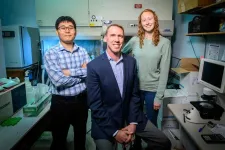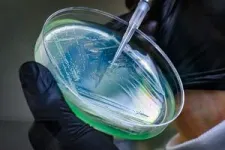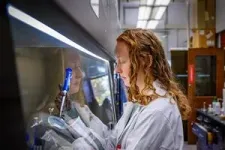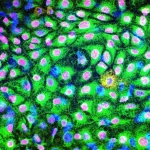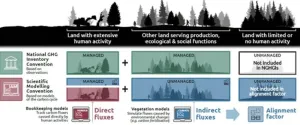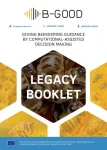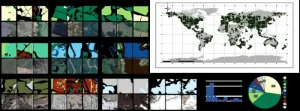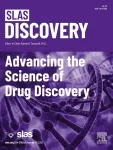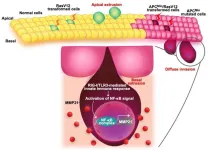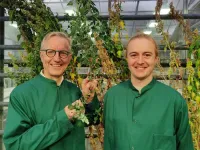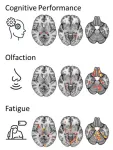(Press-News.org) CHAMPAIGN, Ill. — Researchers report in the journal Nature that they have found a way to get antibacterial drugs through the nearly impenetrable outer membrane of Pseudomonas aeruginosa, a bacterium that – once it infects a person – is notoriously difficult to treat.
By bombarding P. aeruginosa with hundreds of compounds and using machine learning to determine the physical and chemical traits of those molecules that accumulated inside it, the team discovered how to penetrate the bacterium’s defenses. They used this information to convert an antibacterial drug that previously had no activity against P. aeruginosa into one that did.
“Pseudomonas is still the most difficult to treat gram-negative infection, and gram-negative infections are very challenging to treat in general,” said University of Illinois Urbana-Champaign chemistry professor Paul Hergenrother, who led the work with former graduate student Emily Geddes, a handful of other graduate students and postdoctoral researchers in the Hergenrother lab and collaborators at Roche. “The Food and Drug Administration has not approved a new class of antibiotic drugs against gram-negatives in over 50 years.”
Gram-negative bacteria differ from gram-positive in the composition of their cell walls. P. aeruginosa has a tightly packed outer membrane that’s negatively charged, Geddes said. “This makes it really hard for other molecules to get through by passive diffusion.”
P. aeruginosa also has other defenses, including highly specialized porins that allow it to bring in specific nutrients while keeping out everything else, and efflux pumps that eject unwanted compounds, Geddes said.
Pseudomonas has 12 efflux pumps, Geddes said. “That really gives it a diversity of drug-resistance mechanisms that some other bacterial species just don’t have.
“Our goal here was to basically test a bunch of compounds to see what types of molecules get in the bacterial cell and stay in the cell, and hopefully learn some design principles from that,” she said.
Earlier studies of P. aeruginosa focused primarily on antibiotics, testing which ones could kill or weaken the bacterium, Hergenrother said.
“We took a different approach – testing a variety of nonantibiotic compounds and tracking which ones accumulated inside. We then used machine learning to make sense of the chemical traits that were common to the accumulators,” he said.
This approach revealed that, among other traits, compounds with a positive charge on the surface and those with more hydrogen-bond-donor surface area were more likely to accumulate inside P. aeruginosa.
Such compounds “can create sort of a gap in the bacterial membrane and destabilize it to let other things come through,” Geddes said.
Once they knew what characteristics a compound must have to penetrate Pseudomonas, the researchers chose to test those rules by modifying an existing antibiotic drug, fusidic acid, that is used to treat gram-positive infections but has no activity against gram-negative bacteria. The researchers modified the drug to create a derivative form, called FA prodrug, that included the features identified in the machine-learning exercise.
The experiment worked, Geddes said.
“As we increased the positive charge and as we increased the hydrogen-bond-donor surface area, we saw a corresponding increase in accumulation of the FA prodrug in Pseudomonas,” she said. “We saw a 64-fold improvement in activity with those changes.”
“Fusidic acid alone has no activity whatsoever against Pseudomonas,” Hergenrother said. “And so being able to build that in is a pretty powerful demonstration of the rules.”
The FA prodrug itself probably will not be pursued as a candidate drug to fight Pseudomonas infections, Geddes said. But the principles learned in the study will aid the design of new compounds to fight these dangerous, drug-resistant infections.
Hergenrother also is a professor in the Carle Illinois College of Medicine and the Carl R. Woese Institute for Genomic Biology, and deputy director of the Cancer Center at Illinois.
The National Institutes of Health supported this research.
Editor’s notes:
To reach Paul Hergenrother, email hergenro@illinois.edu.
To reach Emily Geddes, email emilyjgeddes@gmail.com.
The paper “Porin-independent compound accumulation in Pseudomonas enables antibiotic discovery” is available online or from the U. of I. News Bureau.
DOI: 10.1038/s41586-019-0000-0
END
Cell and organ transplants can be lifesaving, but patients often encounter long waiting lists due to the shortage of suitable donors. According to donatelife.net, in 2021 6,000 people died in the U.S. alone while waiting for a transplant. One day, transplants generated from stem cells may alleviate the constant organ donor shortage, making transplants available to a larger group of patients.
An issue with donation, whether it’s with solid tissues or cells from deceased or living donors, is immune rejection. Unless the donor material is carefully matched to the recipient’s immune system, the transplant will be rejected. However, stem cell research ...
Effective management of land, whether for agriculture, forests, or settlements, plays a crucial role in addressing climate change and achieving future climate targets. Land use strategies to mitigate climate change include stopping deforestation, along with enhancing forest management efforts. Countries have recognized the importance of the land use, land-use change, and forestry (LULUCF) sector, with 118 of 143 countries including land-based emissions reductions and removals in their Nationally Determined Contributions (NDCs), which are at the heart of the Paris Agreement and the achievement of its long-term goals.
A new study, published in Nature, demonstrates that estimates of current land-based ...
The aim of the B-GOOD project (Giving Beekeeping Guidance By Computational-Assisted Decision Making) was to pave the way towards healthy and sustainable beekeeping within the European Union by following a collaborative and interdisciplinary approach. By merging data from within and around beehives, as well as wider socioeconomic conditions and by developing and testing innovative tools to perform risk assessments, B-GOOD provided guidance for beekeepers and helped them make better and more informed decisions.
The communication of scientific information and the transformation of scientific ...
As the planet gets hotter, animal and plant species around the world will be faced with new, potentially unpredictable living conditions, which could alter ecosystems in unprecedented ways. A new study from McGill University researchers, in collaboration with researchers in Spain, Mexico, Portugal, Denmark, Australia, South Africa and other universities in Canada, investigates the importance of temperature in determining where animal species are currently found to better understand how a warming climate ...
Tracking unprecedented changes in land use over the past century, global land cover maps provide key insights into the impact of human settlement on the environment. Researchers from Sun Yat-sen University created a large-scale remote sensing annotation dataset to support Earth observation research and provide new insight into the dynamic monitoring of global land cover.
In their study, published Oct 16 in the Journal of Remote Sensing, the team examined how global land use/landcover (LULC) has undergone dramatic changes with the advancement of industrialization and urbanization, including deforestation and flooding.
“We ...
Oak Brook, IL – The latest issue of SLAS Discovery is a joint Special Collection between SLAS and the Society of Biomolecular Imaging and Informatics (SBI2) to celebrate the 10th Annual SBI2 High-Content Imaging and Informatics meeting. This collaboration features a curated special collection of articles that highlight the significant impact of high-content imaging in basic and translational research. Volume 28, Issue 7 features one perspective, four original research articles and one short communication.
Perspective
Evolution and Impact of High Content Imaging
This ...
Fukuoka, Japan—Researchers at Kyushu University have developed a new tool to help clinicians and researchers assess individuals for pathological social withdrawal, known as Hikikomori. The tool, called Hikikomori Diagnostic Evaluation, or HiDE, can be a practical guide on collecting information on this globally growing pathology.
Hikikomori is a condition characterized by sustained physical isolation or social withdrawal for a period exceeding six months. It was first defined in Japan in 1998, ...
Living cells compete with each other and try to adapt to the local environment. Cells that are unable to do so are eliminated eventually. This cellular competition is crucial as the surrounding normal epithelial cells use it to identify and eliminate mutant cancer cells. Studies have reported that when activating mutants of “Ras” proteins are expressed in mammalian epithelial cells, they are pushed toward the lumen, excreted along with other bodily waste, and eliminated by competition. Epithelial cells containing Ras mutants have been reported to be removed in this manner in several organs, including the small intestine, stomach, pancreas, and lungs. ...
Quinoa and many other extremely resilient plants are covered with strange balloon-like 'bladders' that for 127 years were believed to be responsible for protecting them from drought and salt. Research results from the University of Copenhagen reveal this not to be the case. These so-called bladder cells serve a completely different though important function. The finding makes it likely that even more resilient quinoa plants will now be able to be bred, which could lead to the much wider cultivation of this sustainable ...
CHICAGO – People with long COVID exhibit patterns of changes in the brain that are different from fully recovered COVID-19 patients, according to research being presented next week at the annual meeting of the Radiological Society of North America (RSNA).
“To the best of our knowledge, this is the first study comparing patients with long COVID to both a group without history of COVID-19 and a group that went through a COVID-19 infection but is subjectively unimpaired,” said one of the study’s lead authors, Alexander Rau, M.D., resident in the Departments of Neuroradiology and Diagnostic and ...
